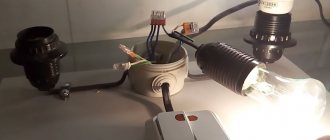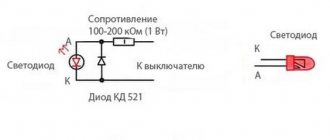Here is one of the typical diagrams of an energy-saving lamp.
A voltage of 220V is supplied to the diode bridge. The result is a constant voltage of a certain ripple. To level out these ripples, capacitor C4 is used. It is this capacitor that is the culprit.
Blinking LED and energy saving lamps
If you have switches with LED or neon backlighting, when installing economy lamps (they are also called energy-saving or compact fluorescent), they begin to blink when the light is turned off.
The same situation occurs with some (cheap Chinese) LED lamps. They turn on briefly - for a fraction of a second - and turn off instantly. This repeats quite often - every couple of seconds. The reason is simple. An LED or fluorescent light bulb blinks when the light is turned off due to the presence of the backlight LED power circuit and the design features of these lamps. Unlike incandescent lamps, energy-saving and LED lamps operate on 12 V DC. But they are connected to a 220 V network, and the conversion takes place in the lamp base, where a diode bridge and a capacitor are installed - a circuit that converts 220 V AC to 12 V DC .
The switch backlight power circuit creates the conditions for charging the lamp capacitor. When you turn the switch to the "off" position, there is still a circuit to power the LED/neon bulb, which is what causes them to glow. Microcurrents flow through this circuit - no longer needed for illumination. They are small, but they are enough for the capacitor in the lamp to accumulate a charge sufficient to start the lamp (which is installed in the lamp base). As a result, the lamp lights up. But, since the charge is still too small and there is no normal replenishment, the lamp quickly goes out. This is how you get a blink.
Sometimes - with some switches - the lamps do not blink, but remain incandescent. This happens because the resistance in the backlight power circuit is low. As a result, the current is enough to maintain a small charge on the capacitor. That is why it turns out that the lamps burn when the lights are off. This most often affects LED lamps. The methods of dealing with this phenomenon are the same as with blinking.
The situation when the light blinks when the light is off is not only unpleasant for the eyes. There is one more consequence: each lamp is designed for a certain number of on-off switches. When you blink, this cycle occurs in a split second. There can be 10 or more of them per minute. It is clear that very soon the lamp will fail. So, it is necessary to deal with the fact that a light bulb is blinking when the light is turned off immediately after detection.
Poor quality lamp
Often the lamp breaks down and begins to blink simply due to the use of low-quality materials for insulating wires, cheap consumables for soldering circuit components (flux, etc.), violations of production technology (careless washing of circuit boards, etc.). All this leads to unpredictable results during operation, including the occurrence of leaks. Therefore, you should buy lamps from well-known manufacturers, although they are somewhat more expensive. A version of the rating of manufacturers of energy-saving lighting devices is shown in the table:
| Place | 1 | 2 | 3 | 4 | 5 |
| Manufacturer | Philips | LIGHTSTAR | UNIEL | OSRAM | Camelion |
| A country | Netherlands | Italy | China | Germany | Hong Kong |
You should also pay attention to the Russian brand Era.
It should be taken into account that when disassembling failed lamps, traces of condensation accumulation are often found. Most lamps have a leaky design, which over time leads to massive failure of lamps operated in conditions of high humidity. This can also cause current leaks inside the energy-saving control circuit.
Important! This method does not require additional costs; it only requires a spare lighting element. In order to save time and money on troubleshooting, it is recommended to do a trial replacement of the lamp first. Further diagnostics should be carried out in case of an unsuccessful outcome.
Reasons for the glow
There are several known reasons why LED bulbs glow when the switch is off. The main ones are:
- the presence of a special backlight in the switch that switches the lamp circuit (it can become a source of blinking);
- break of the neutral wire or damage to the insulating sheath of the power cable;
- errors in connecting LED bulbs;
- defective LEDs used in the design of the lighting device;
- Poor contact of the lamp base with the wire coming from the control board.
This glow does not pose any danger to electrical wiring, but the guaranteed service life of lighting fixtures installed in a chandelier, for example, is reduced. Next, each of the listed cases will be considered in more detail.
Reason No. 2 and its solution
If your switch is not backlit, and the LED or economy lamp blinks when the light is off, then there is a connection error. Most likely, it is not the phase that is broken on the switch, as it should be, but the zero. In addition to the fact that this is very dangerous, it leads to the following phenomenon - the blinking of some lamps.
When the switch is connected correctly, the phase is broken with the key
This can be eliminated by correcting the error - you need to check which of the wires the phase is on and connect the switch correctly. If all the switches on this line are connected incorrectly, you can switch the wires in the panel. If only part of it, you will have to do this on each incorrectly connected switch.
Why do you need to eliminate the flickering of an energy-saving lamp?
In addition to the fact that constant blinking effectively interferes with rest, it also reduces the life of the lamp. If the problem is not promptly resolved, then you can forget about the phenomenal performance declared by the manufacturer. On average, an energy-saving lamp can work for about 10,000 hours while consuming a minimum of energy. Blinking reduces this period by approximately 2 times. In this case, it is worth considering the original quality of the lamp.
However, you should not immediately take radical measures without first trying simple methods to solve the problem. You can always figure out the wiring or switches, but you should start by replacing the light bulb itself. When dealing with a major intervention, you should be extremely careful, and it is better not to try to deal with wiring or switches without having the necessary skills. When working with electricity, be sure to follow the safety rules:
- turn off the power supply at the panel in the apartment or staircase
- warn neighbors about ongoing work
- make sure there is no electricity
If everything is done correctly, the energy-saving lamp will stop blinking when the light is turned off and will last its entire duration.
You can get professional advice, and if necessary, help from a specialist, by applying for the services of a specialist through the Yudu service.
Shunting with a resistor
You can combat blinking by shunting the circuit with a certain resistance. To do this, take a resistor with a resistance of 1 mOhm and a power of 0.5 to 2 W.
For safety, it is better to insulate it with heat shrink.
The best connection location for the resistor is at the junction box. Connect it between the neutral and phase wires of the light bulb (in parallel with the energy-saving wire). It is especially convenient to connect this resistor through Wago clamps.
After this, your lamp will stop blinking.
If your junction box is hidden and there is no access to it (although this is already a violation), or there is no free space in it, then the resistor can be soldered directly to the phase and neutral wires of the chandelier. Then hide the ends in the terminal block.
The method has a big disadvantage.
The resistance will heat up, and if the power is selected incorrectly, it can even lead to a fire.
In addition, modern electronic meters in the apartment will take into account the energy consumption for heating the resistance, and you will end up paying not only for lighting, but also for this “modernization”.
Fixing the problem
Once you understand why the energy-saving light bulb blinks when the switch is off, it is easy to propose a solution to the problem:
- Open the microcurrent circuit by turning off the backlight on the switch.
- Change the parameters of the backlight power circuit so that the current is insufficient to charge the capacitor.
- Wrap the currents in a circuit with less resistance.
Replace the switch with a model without backlight or install other lamps.
Why does the LED light blink when the lights are off? If we are talking about a chandelier with several arms, there is another way - you can put an incandescent lamp in one of the arms. The method is quite simple, but it works. If single light bulbs flicker, you will have to deal with the phenomenon using other methods. There probably won’t be any problems with replacing switches and lamps, but there may be problems with other methods.
Why does the light blink when connected correctly?
If the connections to the lamp are correct and the flickering continues, you need to ensure that the wiring is correct. The purpose of the switch is to connect and disconnect the phase contact. In some cases, the switching hits zero, so a flashing effect occurs. The contact in the junction box needs to be changed; in rare cases, a new cable may be needed.
When the light bulb is located far from the switch and distribution box, an EMF can be induced on the wires. This effect often causes flickering of fluorescent lamps. In this case, the source can be a nearby cable, actively used gadgets and electrical appliances.
Insufficient quality of light bulb
Poor quality lighting fixtures are another factor leading to flicker. To avoid this problem, it is recommended to adhere to a number of rules:
- You should select a light bulb taking into account the power parameters, which are contained in special tables and indicated by the manufacturer in the product labeling.
- Many energy saving lamps have an E27 base. However, if we are talking about local lighting, E14 sockets are needed.
- Different types of rooms require different color temperatures. For offices this is 6 - 6.5 thousand on the Kelvin scale, for living rooms and children's rooms - 4.2 thousand Kelvin, and for a kitchen or bedroom - 2.7 thousand.
You should not purchase too cheap lighting fixtures from little-known manufacturers. Such savings often result in rapid breakdown of the device. Products from well-established companies are a smarter choice. The warranty period for the product ranges from 6 to 18 months.
Reasons for blinking when the lights are off
The household electrical network uses alternating current. In order for the LEDs to work properly, the connection circuit is equipped with a rectifier that filters the current and starts the LEDs. Voltage accumulates in it, causing the lamp to blink after turning off.
There are other negative circumstances that cause LEDs to flicker:
- incorrect connection diagram (zero is connected to the switch, phase is connected to the lamp, the neutral wire is grounded);
- the switch is equipped with backlight;
- there are devices nearby that create a powerful magnetic field (radio station, mobile phone tower, large TV);
- the wall along which the wiring is laid is damp;
- There are several wires in the groove.
All these phenomena contribute to the emergence of currents called parasites. They interfere with the normal operation of LED bulbs.
The lamp lights up after turning off - solutions to the problem
Having decided why the LED light is on when the light is off, you can move on to solving the problem. The following is a list of basic recommendations, depending on the causes of this phenomenon. If dim light is associated with purchasing a product at an affordable price, but of low quality, then the advice here is very simple - you need to go to the nearest store and buy a high-quality light bulb from a reliable manufacturer.
If the problem is the backlight in the switch, there may be several solutions. You can act logically and, following the example of the first point, go to the store for a switching device that does not have backlighting. Another option is to cut off the power wire that controls the backlight. To do this, you will need to open the switch, which is done quite simply and quickly; even beginners in this matter will be able to disassemble and reassemble the device on their own in a few minutes. If you cannot do without backlighting, then you can just install another resistor in the circuit, which will prevent the accumulation of energy.
The main thing is to find the cause of this glow, after which you can begin to take action. Isolation, as noted earlier, causes the greatest difficulties in solving the problem. If you do not want to violate the integrity of the wall, then you can try to go the other way. Its essence is to connect an additional load (relay, resistor, incandescent lamp) in parallel with diodes that do not stop burning. The only condition is that the resistance of the connected additional device must be less than that of the LED lamp. Due to the weak resistance, the connected element will not light up, and due to the redirection of current, the LED lamps will also not light up after turning off.
So, we told you why LED bulbs light up when the switch is off, and also that solving such a problem is not so difficult. The main thing is to find the cause of this glow, after which you can begin to take action.
Preventive measures
Whatever the reason for the lamp blinking, this phenomenon causes not only a feeling of discomfort. The problem is that the life of the lamp is exhausted so quickly. It is used up in a few months, after which you need to purchase a new and far from cheap lamp again.
It is easier to prevent any problem than to fix it. Therefore, the following preventive measures are suggested to reduce the likelihood of flashing effect occurring when the voltage is removed:
- Purchase only high-quality energy-saving products from well-known manufacturers.
- If installation is carried out independently, follow the correct connection diagrams. If a third-party specialist is hired for the work, supervise his work.
- Monitor the condition of the electrical wiring.
- In damp rooms, use only sealed lamps.
The time of energy-saving lamps on the market appears to be coming to an end. They lost the competition to LED lamps in all respects and to incandescent lamps in terms of price and environmental friendliness. But the energy-saving devices that remain in operation can still serve the owners. They just need to be used correctly.
Errors in connecting the lamp
An LED lamp can light up after being turned off only because, due to installation errors, the switch was installed not in a phase break, but in the “zero” circuit. In this situation, when the lamp is disconnected from the network, a voltage of 220 Volts will be applied to one of its contacts, which, due to the design features, will cause it to flicker weakly or glow dimly.
You can learn more about this situation from the video:
Another common reason for LED lights blinking after the switch is turned off is errors associated with non-compliance with the rules for their installation. This case concerns, in particular, the situation when a capacitor is connected in parallel to the light bulb, not supplemented with a special discharge circuit.
Pass-through switch
You can also use a pass-through switch instead of a regular one. In this case, the light will be on in one position, and the backlight in the second. The light will also not blink.
This is achieved by direct supply of only neutral conductors to the lamp in the off position.
And no amount of interference will make it light up.
True, here you also need to connect the neutral conductor to the switch. But this method allows you to get rid of blinking, even when the backlight is not the cause! (discussed below). If you are not too bothered by the additional costs associated with purchasing a pass-through switch, and you do not want to go into the weeds of choosing suitable resistors and capacitors, then this method is the most optimal.
How to solve the problem of dim light
Recommendations may vary depending on the size of the problem:
- If you initially purchased a cheap LED lamp, then it is possible to eliminate the glow only by installing a product from a reliable manufacturer and of high quality.
- When the problem lies in the backlit switch, it can be eliminated in different ways. The simplest solution is to change the switching device to a model without backlight. You can also cut off the corresponding backlight power wire; this is done after opening the switch. But in some cases it is important to preserve this function. Then you need to install a resistor in parallel on the desired section of the circuit.
- The hardest problem to fix is the one in the wiring. To do everything correctly, of course, it is recommended to find the source of the leakage current. But, as already mentioned, this will entail other difficulties. But as a result, when the light is turned off, the diode lamps will not light up. But you can go another way, a simpler one. To do this, a load (incandescent lamp, resistor or relay) is connected in parallel with the diodes that light up. It is important that the resistance of this element is less than that of LED emitters. As a result, the leakage current will flow, for example, to an incandescent lamp. But due to the slight resistance it will not burn.
As you can see, there are many ways to solve the problem of diode-based emitters, which, although dim, still shine when turned off. It is necessary, if possible, to determine the most likely cause of this phenomenon.
The main provocateur
Despite the fact that a fairly large number of factors were listed above that can lead to flickering of energy-saving light sources, the most common reason for this effect is the presence of a backlight on the key switch.
Keyboard switch off with backlight
Both a neon lamp and an LED can be used as a backlight. Note! Before buying an energy-saving light bulb, carefully read the instructions for it. Typically, manufacturers provide information in the instructions about whether their products can be used simultaneously with such illuminated switches. The reason for the blinking of the light source in this situation is the backlight being supplied with electric current. Despite the fact that so little energy is spent here that the meter does not notice it, the light bulb reacts to even such a small amount of energy. As a result, the capacitor is charged and creates a blinking effect. When there is a flash of light, the capacitor is discharged and the entire process is repeated. That is why, if there is a backlit switch, such a reaction of energy-saving models is possible. Note! Such flickering negatively affects the lifespan of an energy-saving light bulb, which is why it can last much less than the period specified by the manufacturer.
Independent search for the cause of the malfunction
If an energy-saving lamp used in a lamp or other product begins to blink, then you need to start fixing the problem immediately. Since each lighting device has resource limitations in terms of the number of starts.
That is, each such cycle reduces the operating time, and if they are repeated frequently, then in just a few days the service life will be reduced by many months, or even years. In addition, as mentioned above, if the wiring is faulty, there may be a threat to the health of the home owner, his family and friends, which should not be allowed.
Troubleshooting should only be carried out by a trained technician, using a special tool in compliance with all safety measures provided for in the governing documents. The troubleshooting procedure should begin with the simplest methods that do not require costs. And if they don’t give results, then move on to more complex ones.
So, first of all, you need to check the functionality of the light bulb itself. Why can it be moved to another place, tested with neighbors and acquaintances. If the blinking continues, then you just need to replace the lighting fixture. When, after installing the lamp in a new location, the malfunction does not appear, then the switch should be replaced. In order not to waste money, you can take it from another place for testing and, preferably, it should be without a backlight. When the cause is identified, you should simply buy and install a new switch.
If this does not produce results, then the owner of the premises should look for a problem in the wiring. But when performing any electrical work, it is important to remember that all of it is potentially dangerous. Therefore, you need to follow measures to prevent and avoid risky situations, have sufficient skills and have the appropriate tools.
The information in the following article will help you find out the reason why the LEDs glow after disconnecting from the power supply.
Reasons for current accumulation on a capacitor
Despite the accumulation of electricity in the filter capacitor, in most cases it remains operational. And the very presence of current simply indicates a problem.
Its source can be 3 reasons:
- Backlight lamps located on the switch.
- Presence of leakage currents.
- The exhausted life of the lamp itself and its individual elements. For example, the starter of a fluorescent energy-saving lamp.
To solve the problem quickly and at low cost, you should take a closer look at the causes of flickering/blinking.
Reason #1 - switch backlight lamps
The industry is trying to increase the competitiveness of its products by making them more functional and convenient.
For this purpose, many switches are equipped with backlight lamps, which help people easily find their location in the dark. But the way they are connected to the circuit often allows current to flow to the filter capacitor, which will cause blinking.
The photo shows filter capacitors. They are able to accumulate a certain amount of current and supply it to the lamp starting circuit
This happens due to the fact that the backlight lamp is installed parallel to the switch itself. This is done so that this element can always perform its duties.
But when the switch contacts are open, all available electric current flows to the backlight. And then a small amount of it falls on the energy-saving lamp, which leads to abnormal operation of the filter capacitor. This phenomenon is so common that it has become the main cause of blinking.
Using an incandescent lamp of any wattage or additional resistance in the circuit are simple ways to troubleshoot the problem. The photo shows the last option
It is easy to combat this cause, and there are several simple methods from which a person can choose the appropriate one.
Method #1 . Replacing the switch with a product without a backlight. It is not expensive and the problem can be fixed quickly.
Method #2 . Disconnect the backlight wires - that is, you just need to break the power circuit by cutting the necessary wires. Any specialist or the user himself can do this in a few minutes if he has the appropriate skills. This solution is considered the most inexpensive, but you will have to sacrifice the lighting.
Method #3 . Add an incandescent lamp - in this case, all the current from the backlight lamp will be spent on heating its filament. And since the supply of electricity is small, this will not lead to any results, but the filter capacitor will not blink.
The advantage of this option is that the backlight can be preserved, and the cost of elimination will be minimal. But the aesthetic properties of this method are questionable, since it is problematic to disguise an incandescent lamp in any chandelier.
Method #4 . Add a low-power resistance to the circuit - this solution to fixing the problem is similar to the previous one. That is, the additional element will consume the entire supply of current, which is why it will not accumulate in the filter capacitor.
The recommended resistance power is 2 W, while the rating should be within 50 kOhm. This option is the least popular.
Method #4 . Connect the backlight to the wiring separately from the switch itself. Thus, it is possible to save the LED. But it will work constantly, that is, even in the on position of the switch, although the costs will be insignificant.
If you use a switch without backlight, it will be less convenient, but the person will significantly reduce the likelihood of blinking or flickering
Despite its simplicity, the feasibility of this option is questionable; even for safety reasons, it is better for a person to get by with any of the previous methods.
Since the described case is the most common reason for electricity entering the filter capacitor, and, consequently, for the blinking of energy-saving lamps, then you need to start looking for the problem with it.
It may also be useful to know that modern switches use two types of backlight lamps: neon and LED. And most often it is the first type of lighting that leads to abnormal operation.
Reason #2 - presence of leakage currents
Often the wiring or other circuit elements are in poor condition. Which can lead to the formation of so-called leakage currents.
That is, despite the switch being turned off, electricity can again be supplied to the filter capacitor. As a result, the energy-saving lamp used blinks/flickers.
Damage to the wiring is far from the most common, but one of the most unpleasant reasons for the blinking state of energy-saving lamps
Such cases are less common than abnormal operation of the backlight, but this option can be much more dangerous. Since only serious reasons can lead to the appearance of leak points.
These include the following:
- Insulation damage.
- Incorrect electrical installation.
- Poor connection.
Any damage to the insulation may occur if low-quality wires or other circuit elements are used. And also resource depletion can lead to these consequences. That is, insulation is often destroyed due to its “venerable” age.
Incorrect wiring also often leads to the fact that when the circuit is broken by a switch, current will still flow to the lamp. This happens when the rules for performing work are grossly violated.
As a result, the switch breaks the so-called zero, but the phase that is not needed in this case. You can identify such an oversight yourself using a voltage indicator, which can be successfully replaced with an electrical clamp.
Sometimes blinking can only be eliminated by replacing the wiring, which is expensive, but this is a necessary procedure - otherwise, there is a possibility of more severe financial losses, and there is also a threat to human health
Poor electrical installation also often leads to leakage currents. This can happen due to a number of reasons. These include poor connection of wire cores or incorrect connection to other elements of the circuit. For example, poor contact between the wires and the switch connector.
The owner of the premises needs to understand that poor wiring poses a danger to the health and life of every person who is in it. This is especially true for situations where the old and inefficient Soviet TN-C system is used as grounding. Therefore, immediately after identifying any shortcomings, they must be eliminated immediately.
Reason #3 - exhausted lamp life
All kinds of modern lighting devices have a huge resource, but this too will someday be exhausted. Therefore, this reason for the blinking of the lamp should also be kept in mind, since this is not uncommon.
And the likelihood of such a problem becomes especially high when the energy-saving lamp has worked for several years. Moreover, a person should not be surprised that the manufacturer promised a service life of 10 years or more, but the malfunction appeared earlier.
It should be remembered that you should not skimp too much on the quality of components and the electrical installation itself. Since this often results in additional and significant financial losses
There are many objective reasons for early resource depletion. For example, these may be voltage surges, low or high temperatures, and other non-optimal conditions. By the way, blinking itself also leads to premature failure of any lighting device.
Most often, the cause of flickering of fluorescent energy-saving lamps with expired service life is a faulty starter. In this case, you can get out of the situation by simply replacing the specified element, especially since it is inexpensive.
It is also worth remembering that the buyer may receive a low-quality lighting device. To avoid this, it is necessary to purchase products from world-famous manufacturers.
For example, these are Philips, OSRAM and a number of others. Their products are more expensive than those from domestic or other manufacturers, including Chinese, but defects are extremely rare, and the performance characteristics correspond to the declared ones.
Flickering when the switch is on
Now let's try to figure out why the LED lamp flickers when the light is on and how to fix this problem.
Mains voltage too low
The most common reason for an LED lamp to flicker when turned on is low voltage in the electrical network. In some urban areas and rural areas, people have come to terms with outlet voltages of no more than 200V. In such residential areas, only an LED light bulb with a high-quality built-in driver can work stably and shine efficiently.
It is recommended to buy LED lamps with an operating voltage range from 180 to 250V.
Also, low voltage on the light bulb may appear when it is connected through a dimmer. If the model does not support dimming, then the very first start will be a clear confirmation of this - when the dimmer is not turned on at full power, the light bulb will flicker. When the regulator knob is further rotated to raise the rated voltage, the blinking disappears.
Unstable 220V network voltage is bad for all energy consumers, including LED lamps. If the energy company is not able to stabilize it, then there is only one way out - installing a stabilizer with a capacity of several kW, which is capable of normalizing the voltage in the entire house. With such an “assistant”, LED lamps are guaranteed a long service life.
Separately, it is worth mentioning light bulbs with a supply voltage of 12V, that is, which are connected from a step-down voltage source. Their blinking may be caused by a lack of power from the power supply, resulting in a voltage drop across the load. As a rule, a similar situation arises when replacing halogen light sources with LED ones in spotlights, where they are connected in parallel.
Undervoltage
In remote areas, there is a significant deviation towards lower voltage parameters in the power grid. Sometimes it drops well below 200V. Without a dimmer, ice-type lamps will flicker. Installing a stabilizer at the cable entrance to an apartment or house helps correct the situation. In general, a stabilizer is always needed - minor voltage surges will not damage an electrical appliance, but can significantly shorten its service life.
If there is always increased voltage in the network, choose 220-240V ice lamps that are designed for such indicators.
VIDEO: The phenomenon of blinking LED lamps or how not to connect lamps
Other options
The reasons described above are not the only ones. It happens that the wiring is new, the switch does not have LED backlighting and the zero is not interrupted, but the light bulb still blinks. Why does this happen in this case? Let's consider the possible options:
- The working life of the product has expired. Energy-saving lamps are designed for a minimum of 10 years of operation. Manufacturers say so, but at the same time they make amendments that there must be appropriate conditions for using the product. If your device works longer than the period stated by the manufacturer, then most likely its service life has expired. In this case, the light bulb simply needs to be replaced with a new one.
Please note that the lamp life may be shortened. This may be caused by voltage fluctuations, increased humidity in the room, or too low or high air temperature. In any case, if the lamp has worked for more than 5-7 years and suddenly begins to flicker, most likely it has exhausted its service life.
- You purchased a defective product. Economical light bulbs are produced under strict control, so defective products are quite rare. But there are always exceptions to any rule, and it is quite possible that you have encountered just that. As we have already mentioned, the majority of defects come from Chinese manufacturers. To reduce the risk of purchasing low-quality goods, give preference to domestic or European manufacturers. They cost more, but they last much longer. If the assembly of the light bulb leaves much to be desired, it may cause a short circuit. Such a product must be immediately replaced by the seller. If the replacement is unsuccessful, it is recommended to simply throw away the defective lamp and purchase a new one. You should not risk the property and lives of loved ones because of a banal desire to save money.
- The starter does not work. This part is located inside the product and it is thanks to it that the lamp turns on. When the starter fails, a flickering effect occurs. If the light bulb is new and you hate changing it, try replacing the starter itself. The part can be purchased at any electrical goods store. It costs little, and the method of replacing it is intuitive even for a beginner.











